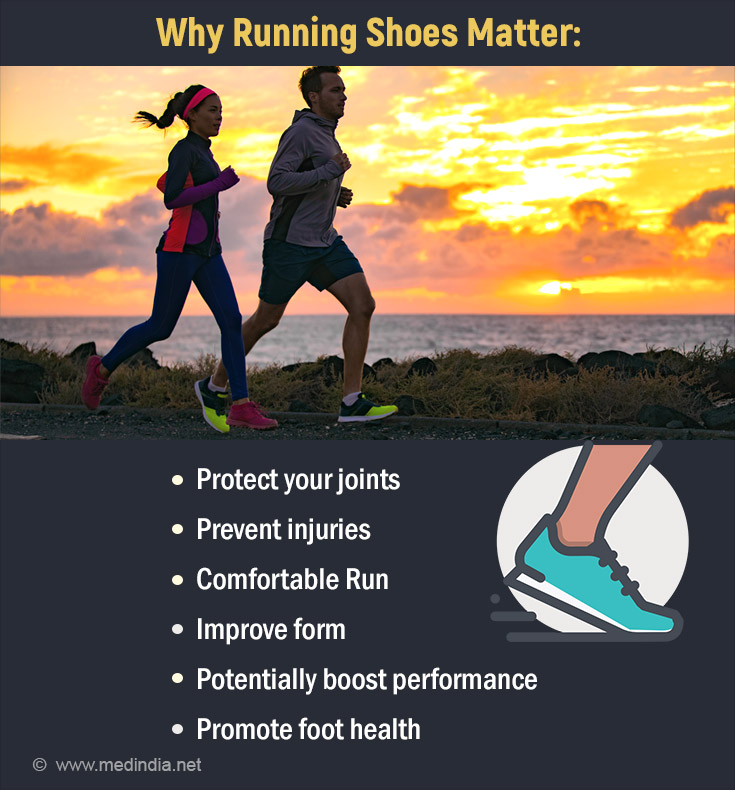- Do Running Shoes Make a Difference? Here's the Science - (https://www.philathletics.org/do-running-shoes-make-a-difference/)
- The Difference between Running Shoes and Walking Shoes - (https://www.dignityhealth.org/articles/the-difference-between-running-shoes-and-walking-shoes)
About
Running is a fantastic way to stay fit and improve your overall health. But pounding the pavement can take a toll on your body, especially your feet and ankles. That's where good running shoes come in. They can be the difference between a pain-free run and a trip to the physiotherapist (1✔ ✔Trusted Source
Do Running Shoes Make a Difference? Here's the Science
Go to source).
Did you know?
Proper running shoes can reduce the risk of injuries by up to 39%! #shoes #runningtips #medindia
Why Running Shoes Matter
Running shoes are specifically designed to absorb impact, provide support, and promote proper foot motion during running. Here's how they can benefit you:
Injury Prevention: Running puts a lot of stress on your joints. Good running shoes cushion your feet and ankles, reducing the impact and helping to prevent injuries like shin splints, stress fractures, and tendonitis.
Comfort: Running should be enjoyable! Proper running shoes provide a comfortable fit and support that can make your runs more pleasurable. Good cushioning can also help to reduce fatigue, allowing you to run further.
Performance: While not a magic bullet for speed, good running shoes can help your running form by providing stability and responsiveness. This can lead to a more efficient stride and potentially improve your running performance.
Foot Health: Wearing proper running shoes helps maintain foot health by providing adequate support to the arches, heels, and toes, preventing conditions like plantar fasciitis and bunions.

Walking Shoes vs. Running Shoes: What's the Difference?
You might be tempted to use your regular walking shoes for running, but there are some key differences (2✔ ✔Trusted Source
The Difference between Running Shoes and Walking Shoes
Go to source):
Cushioning: Running shoes have a thicker, more shock-absorbing midsole to handle the higher impact forces of running. Walking shoes typically have less cushioning, which is fine for walking but not enough for the demands of running.
Support: Running shoes often have features like stability posts and medial support to control overpronation (excessive inward rolling of the foot). Walking shoes generally lack these features.
Flexibility: Running shoes have a more flexible forefoot to allow for natural toe movement during the running gait. Walking shoes may be stiffer, which can be uncomfortable for running.
Weight: Running shoes are usually lighter than walking shoes to reduce fatigue during long runs. The lightweight design helps runners conserve energy and maintain a quicker pace.
Heel Design: Running shoes often have a beveled heel for smoother heel-to-toe transitions, which is critical for running mechanics. Walking shoes may have a more pronounced heel.
Outsole: The outsole of running shoes is designed for durability and grip on various surfaces, while walking shoes have a simpler tread pattern suited for smoother surfaces.
Toe Box: Running shoes usually have a wider toe box to accommodate toe splay during running, which enhances balance and comfort. Walking shoes might have a narrower toe box.
Breathability: Running shoes often feature breathable materials to keep feet cool and dry during intense runs. Walking shoes might prioritize durability over breathability.
Finding the Right Running Shoe for You
Not all running shoes are created equal. There are different types of shoes for different foot types and running styles. Some things to consider when choosing a running shoe are:
Gait Analysis: Get your gait analyzed at a running specialty store. This will help determine if you need a neutral, stability, or motion control shoe.
Fit: The fit is crucial. Many running shoes are designed to cater to specific foot shapes and running styles, offering options for flat feet, high arches, and different pronation needs.
The shoe should be snug but not tight, with enough room for your toes to wiggle.
Durability: Running shoes take a beating, so consider durability when choosing a pair. Look for shoes with a well-constructed upper and a tough outsole.
Replacing Running Shoes
Running shoes don't last forever. The cushioning breaks down over time, and worn-out shoes can increase your risk of injury. It's generally recommended to replace your running shoes every 300-500 miles (480-800 km).
While good running shoes can make a big difference, they're not a replacement for proper running form and training. But by investing in a good pair of shoes that fit you well, you can help to prevent injuries, improve your comfort, and potentially enhance your running performance.









